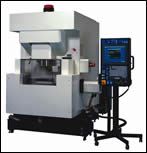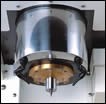Getting To Submicron Accuracy
Machie tools designed for submicron accuracy and subminiature workpieces are following design strategies that depart from conventional practice. The Hyper2J from Makino is described as a case in point.
Share




In nature, scientists are sometimes able to distinguish one species from another only by examining DNA, the unique genetic code in every living cell. In these cases, external appearances do not offer reliable clues. This is much the case with a new breed of vertical machining centers designed for submicron accuracy. These machines do not look strikingly different from other precision machine tools. Yet the submicron model has hidden features and subtle attributes that prove it to be a very different creature, one that has evolved to function in an environment where microns and nanometers (millionths and billionths of a meter) are critical.
Some of the ways in which these machines are likely to deviate from normal expectations for a VMC can be observed in the Hyper2J from Makino (U.S. headquarters in Mason, Ohio). Comparable models from other builders may represent further radical departures from the norm, but looking at this machine helps us understand the design factors that tend to define the "nature of the beast." The chief factors are vibration, heat, rigidity and control unit capability.
- The four-point leveling mounts underneath the Hyper2J rest on a base made of metrology-grade granite that is 250 mm (almost 10 inches) thick. This granite "foundation" isolates the machine structure from vibration in the floor. Granite has 1/10 to 1/20 the thermal conductivity of cast iron, so it resists the effects of ambient temperature changes.
- The spindle is designed to reduce vibration and counter thermal growth. It has a direct tool clamping system that does not require a toolholder or collet. A mechanism inside the spindle uses hydraulic pressure to collapse around the tool shank, much the way the individual hydraulic toolholder would. According to the designers, this feature minimizes rotational vibration inevitably introduced by imperfections in a separate toolholder. Minimizing vibration is a priority because super small cutting tools (end mills with a diameter of 0.03 mm are typical) are susceptible to breakage when subjected to minute vibrations.
- The internal temperature of the spindle is maintained by automatically cooling the lubricant that circulates through it. The work light inside the machine uses LEDs because they are much cooler than other types of lights.
Spindle speeds range from 3,000 to 40,000 rpm (a 170,000-rpm spindle is available.)
- There are no linear motors. Makino has opted for ballscrews and slideways for axis drives, citing the company’s ability to achieve the necessary straightness and smoothness in its production techniques. Maximum feed rates and rapid traverse rates are 12 m/min. (472 ipm).
- The machine has provisions for measuring the position of the tool tip to less than 1 micron. An "ultra-low pressure" contact-type measuring device determines tool length. A proximity-style non-contact spindle positioning device allows the position of the tool tip to be corrected in all three (X, Y and Z) axes. After a tool change, the level of machining surfaces will be higher or lower by less than 1 micron. To detect broken tool tips, an electrical current is transmitted through the cutting tool. If the tool breaks, the disrupted circuit triggers an alarm.
Interestingly, Makino says it has the most experience determining appropriate speeds and feeds for a 0.03-mm diameter carbide end mill. Machine settings for other tools are established on an application-by-application basis.
The axis position feedback system uses a 0.5-nanometer scale to reliably track axis motion commands programmable in steps as small as 10 nanometers. Makino’s stated positioning accuracy for this machine is ±0.3 micron, with a repeatability accuracy of ±0.2 micron.
The control unit, which combines Fanuc hardware for CNC processing with a Windows CE graphical user interface, supports nanometer interpolation and millisecond block processing time. A proprietary "Super Geometry Intelligence" servo control system provides smooth machined surfaces. This kind of smoothing feature grows in importance as cutting tools and programmed steps become so small that workpiece features and tool marks approach the same size range.
Making Submicron Machining Practical
Makino stresses that the Hyper2J is an attempt to make submicron machining in three axes practical for shops intent on moving to this level of accuracy. The company says that the machine is intended for the real world, not the laboratory. The Hyper2J does require a temperature-controlled room. Another version, the Hyper2, incorporates a thermal chamber for controlling its own temperature in ordinary shop environments to achieve submicron accuracy.
Related Content
CNC Machine Shop Honored for Automation, Machine Monitoring
From cobots to machine monitoring, this Top Shop honoree shows that machining technology is about more than the machine tool.
Read MoreHow to Determine the Currently Active Work Offset Number
Determining the currently active work offset number is practical when the program zero point is changing between workpieces in a production run.
Read MoreInside the Premium Machine Shop Making Fasteners
AMPG can’t help but take risks — its management doesn’t know how to run machines. But these risks have enabled it to become a runaway success in its market.
Read More6 Machine Shop Essentials to Stay Competitive
If you want to streamline production and be competitive in the industry, you will need far more than a standard three-axis CNC mill or two-axis CNC lathe and a few measuring tools.
Read MoreRead Next
Setting Up the Building Blocks for a Digital Factory
Woodward Inc. spent over a year developing an API to connect machines to its digital factory. Caron Engineering’s MiConnect has cut most of this process while also granting the shop greater access to machine information.
Read MoreRegistration Now Open for the Precision Machining Technology Show (PMTS) 2025
The precision machining industry’s premier event returns to Cleveland, OH, April 1-3.
Read MoreBuilding Out a Foundation for Student Machinists
Autodesk and Haas have teamed up to produce an introductory course for students that covers the basics of CAD, CAM and CNC while providing them with a portfolio part.
Read More

































.jpg;maxWidth=970;quality=90)